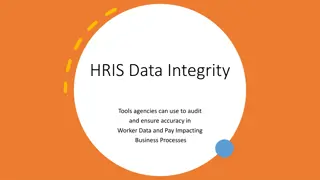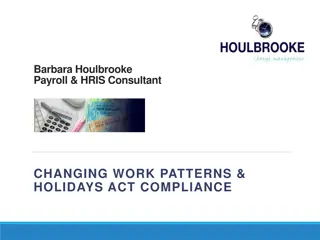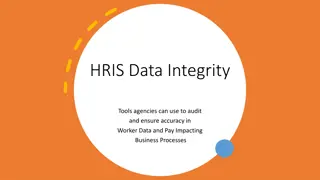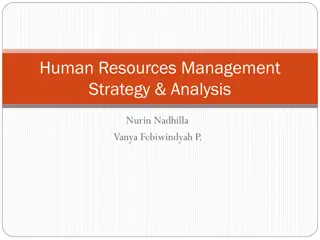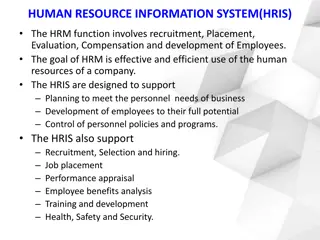
HRIS: Types and Functions in HR Management
Learn about Human Resource Information Systems (HRIS) and its importance in managing employee data efficiently. Explore the types of HRIS, such as Operational, Tactical, Strategic, and Comprehensive, each serving different HR functions. Find out how to determine if your company is ready for adopting HRIS software.
Uploaded on | 2 Views
Download Presentation

Please find below an Image/Link to download the presentation.
The content on the website is provided AS IS for your information and personal use only. It may not be sold, licensed, or shared on other websites without obtaining consent from the author. If you encounter any issues during the download, it is possible that the publisher has removed the file from their server.
You are allowed to download the files provided on this website for personal or commercial use, subject to the condition that they are used lawfully. All files are the property of their respective owners.
The content on the website is provided AS IS for your information and personal use only. It may not be sold, licensed, or shared on other websites without obtaining consent from the author.
E N D
Presentation Transcript
CLASS : M. COM. (P) SEMESTER : IInd SUBJECT : HUMAN RESOURCE MANAGEMENT TOPIC : HRIS DEPARTMENT OF COMMERCE AND MANAGEMENT MADE BY : SONIA DHINGRA I. B. (PG) COLLEGE, PANIPAT AFFILIATED TO KURUKSHETRA UNIVERSITY, KURUKSHETRA
HUMAN RESOURCE INFORMATION SYSTEM (HRIS) HRIS or Human Resources Information System is a Human Resources Software used for information storage, processing, and managing. HRIS helps businesses streamline their employee-related information such as Employee Personal and Job Information, Payroll and Expenses, Time-off, Performance Evaluations, and Benefits. Certain HR Software also has Applicant Tracking as part of it. HRIS becomes the one place to go to for all information required to decide actions, curate reports, and track changes. HRIS can be classified into a few types based on the functions it performs. It is used to solve different challenges or meet different requirements in the HR and Employee Space. The most common classification comes in these 4 types:
Operational HRIS : HRIS functions that help stakeholders perform certain operations are commonly referred to as Operational HRIS. For example, the employee information stored on all employees helps the manager and the organization to fetch them for performing certain functions like placing the employees in the right place within the organizational structure. Knowing the information on their performances to 1. manage it and review it are also part of the Operational HRIS. 2. Tactical HRIS : Tactical HRIS takes care of the processes that help in decision making for the managers with respect to the usage of the resources. This includes actions like Recruiting, Job and Design Analysis, Employee Training and Compensation/Benefits in the organization. All these actions require information on the employees, vacancies in the organization, etc., which is done using Tactical HRIS.
3. Strategic HRIS : Strategic HRIS comes of use when a company is looking to expand or grow, strategically. Strategic HRIS helps in the proper planning of the workforce and know well about the labour resources available. As a part of this, Strategic HRIS holds information that supports workforce planning and a specialized HRIS system on the whole with certain HR functions to help manage and understand labour resources. 4. Comprehensive HRIS : Comprehensive HRIS is more of everything involved in HR actions, including the above three types. It acts as a combined platform with all HR files, employee information, open positions, hiring and job details, job analysis and design files, guidelines files on employee safety, etc., It acts as a place with all information that can be produced at any time to perform any action.
HOW TO KNOW IF YOU ARE READY FOR AN HRIS SOFTWARE? Not all companies require an HRIS. Software costs, year after year and unless you are very sure you would make the best use out of the buy you make, and that it will solve real-time challenges for your organization, it makes little sense to go with an HRIS, at least for now. If you are not sure if your company needs a Human Resource Information System, ask yourself the questions below. 1. What is the employee count of your company? A. Less than 50 Employees B. 50 - 300 employees C. Over 300 employees If you answered B or C, you definitely need an HRIS system, sit down with your HR Department and they probably have a lot of challenges they want to share with you which could help you decide which HRIS best fits for your company.
2. Whats your Hiring Bandwidth or How many open jobs do you have? A. We hire every month and have over 20 open jobs. B. We hire once in 6 months, and we have around 5-10 open jobs. C. We are not hiring currently or in the near future. If you find yourself in the situation of A or B, you most likely need an Applicant Tracking System. If your answer to the first question was B or C, then it s better to go for a HR software that comes with ATS. 3. Are you over 50 employee company and do you offer Time-off/Time-based Pay? A. Yes? Then it would be wise to switch to an HRIS. B. No? Then let s wait.
4. Do you have an elaborate Onboarding Process? A. Yes? Then it would be wise to switch to an HRIS. B. No? Then let s wait. If you did not find your company fit in any of the above situations, it s possibly because you are a company with few employees, you are not actively hiring and can handle HR management on sheets. If your HR team is still feeling challenged, it would be ideal to sit down with them and understand their challenges: Employee Data or Time and Time-off Management, Payroll or Recruitment - based on their requirements you can decide if you need an HRIS or only Payroll or only ATS.
FEATURES OF HRIS The list of features an ideal Human Resource Information System provides vary, so here is a list of the standard features that make up an HRIS. Employee Database Time-off Management Performance Management Applicant Tracking Payroll Onboarding and Offboarding Employee Self-service Mobile HRIS 1. 2. 3. 4. 5. 6. 7. 8.
WHY EVERY COMPANY NEEDS AN HRIS? Increases Efficiency : With the right HRIS in place, the efficiency of your workforce increases by folds. With all repetitive tasks gone to Automation, it takes redundancy off the plate. This gives your employees time to focus on things that matter. 1. Hire Superstars : A meaningful hiring process will happen in your organization once you use the right ATS. The mundane tasks of hiring like preparing reports and maintaining database go off the table enabling your recruiting team to concentrate on the different candidates they process leading to the hiring of genuine superstars. 2. No more Errors : Face it, even the best employer of your organization might slip something and make a mistake, he/she is only human. With a system in place, the chances of making errors or having lags in a work done are reduced vastly. 3.
Healthy Retrospection : Looking back at all the performances, time-off trends, hiring patterns, measuring them using different metrics, generating reports and analytics that give a bird's-eye view with in-depth information helps identify mistakes, best patterns to use and gives scope for rectification and improvement. 4. Improves Employee- Employer Relationship : Human Resource Information System enables you to maintain a system that is transparent about all the information concerning employees like Time-off patterns, performance, goals, referral statuses, etc., leaving no room for scepticism among your employees, this builds trust, loyalty improving the Employee- Employer Relationship. 5. Accurate Decision- Making : All information is in one place for the collaborators with permissions to access, be it for hiring, employee details or Time-off trends, a Human Resource Information System makes the accurate decision-making possible. 6.
Cost- Saving : HRIS means no more storing information manually or across multiple software, not only does this increase the efficiency of usage of information, it reduces the cost spent on different software and the resources used to maintain them. 7. Easy Accessibility and Collaboration : Everything on a cloud system means anyone can access it from anywhere from any device, it also makes collaborating across regions and geographies possible. 8. Improved Employee Ownership : Many HRIS software allows employees to edit their information, update and be proactive on the system giving the employee a sense of ownership and responsibility, it also reduces the back-and- forth talks between the employee and the HR. 9. Easy Maintenance : HRIS system allows you to update, correct or delete information in simple clicks decreasing the time spent on maintaining the system. 10.
STEPS TO FOLLOW AS YOW DECIDE TO IMPLEMENT AN HRIS FOR YOUR COMPANY Step 1: Research, Research, Research : Once you have decided to go with an HRIS for your company, the tough part of finding the right fit for your organization begins. To know and find the right fit for your organization, you have to know extensively about the different HRIS systems available in the market, and also the functions each can perform. By knowing this, you can evaluate the systems that you think can match your needs and break it down to fix on one system. It is important to know the challenges you want to be solved for your company before going for the search. Only when you are aware of the problems you need solutions for, can you even begin the search for the right tool to bring the solutions. Step 2: Huddle up your A-team : Finding an HRIS that fits your company right and implementing it successfully is definitely not a one man s job. Listing down the needs in the system would involve the HR team, talent acquisition team, managers and employees. Researching, communicating with different vendors or suppliers is a task of its own, getting the right people to help implement the software across your company, and bringing top officials on board with the change, etc., all includes getting the right team to work on the whole implementation from the search phase to implement phase.
Step 3: Evaluate and Finalize : When you know your needs, and have your team ready to implement and software that you are almost happy with, evaluate it extensively by rigorously checking its fitment for your needs. Evaluate the system thoroughly and finally take it to the test-run. Step 4: Prepare back up and start a test run : Once you know the software for you, you have to take it to the whole company, this is a huge step, which is why before doing it, you have to be completely sure and amped with resources to help your employees after the system goes live. To do so, prepare a team that can work on any queries or grievances that would be raised by the employees either from your company or get a dedicated team from your supplier or vendor. Once you have the support resources and team ready, test run the system/ software for a few days with few employees and workflows to find any errors or loopholes. Step 5: Go live : If you are confident about the running of the system, all you have left to do is to go live with it in your organization. Communicate to your employees, help them with basic onboarding to the system, handhold for a few days until the company becomes familiar with the system. Collect reviews and feedback to constantly improve the experience provided.
Step 6: Re-evaluate : As much as it is important to evaluate the system before implementing it, it is equally important to evaluate the system after implementation. Give it 90 - 120 days to take its course, once this period is completed, take feedback from major stakeholders using the system, the employees. Evaluate and see if the challenges which you wanted to solve with the system are getting solved or at least have shown improvement. If the system has been successful in changing things for your organization, be proud of your decision, else, take the lesson and repeat the steps to find your correct HRIS system.


